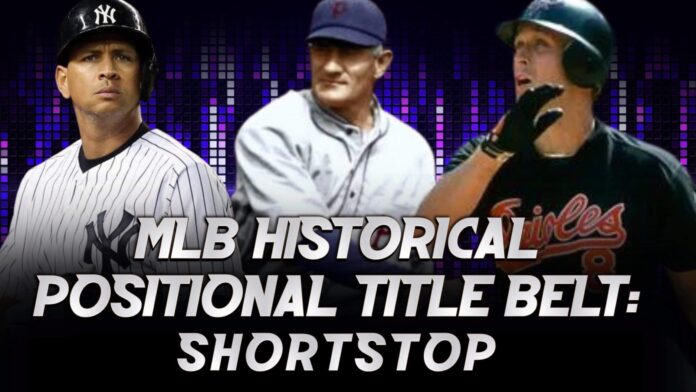Have you ever wondered who the best baseball player alive was in any given year? No? Well, I have. Check out the first article in this series for an explanation of the rules. Next up, Shortstop. To the list!
Pre-Deadball 1871-1900
At the beginning of time or around 1871, baseball, more or less as we know it, became a professional sport. The first 29 years are known as “Pre-Deadball” because they preceded the next era, “Deadball” and came before the first World Series. It’s like Baseball’s B.C. The defensive demands of shortstop tend to result in a team using the most athletic infielder or even the most athletic player overall at the position. The early years have several good examples of that starting with a two-way star.
John Montgomery Ward 1878-
John Montgomery Ward is the epitome of the old-timey baseball man. An excellent pitcher (threw the league’s 2nd perfect game), an elite fielder, and a productive hitter there was little Ward didn’t excel at on the diamond. In fact, Monte also had a successful managerial career, owned the Boston Braves for a time, and organized the first player’s union.
George Davis 1898-
Taking the belt from Ward, was Spiders, Giants, & White Sox standout George Davis. While his offensive numbers never rivaled contemporaries such as Anson or Brouthers, Davis was steadily elite for an extended peak from 1893 to 1902, logging 4.0 or more fWAR every season and exceeding 130 wRC+ 4x over that span. He was so consistently valuable that he accumulated 167.8 wcWAR+, 4th all-time among SS. Between Davis and the next belt holder, Wild Bill Dahlen (150.1) was shut out. Sadly, he’s also been shut out of the HOF to this point, but by value, he’s the 6th greatest SS of all time; somebody should do something about that.
Deadball 1901-1919
The Deadball era was known for speed, bat-to-ball skills, terrible fields, horrible defense, and dominant pitching. Due to the dearth of offense, there was a collection of shortstops who had solid careers but few who reached great heights. Maybe the greatest to ever stand in the gap and a few cameos wore the belt during the era.
Honus Wagner 1896-
The early days of baseball had several legendary figures, Cy Young, Ty Cobb, Cap Anson, Ross Barnes, Lefty Grove, Nap Lajoie, and even John Montgomery Ward. John Peter Wagner, Honus, The Flying Dutchman, was one of the most legendary. Speed & power, offense & defense, on base & slugging, versatility & consistency, longevity, postseason success (basically took Cobb down head to head in 1909 for the World Series), Honus had it all. He won 8 batting titles, racked up 105 Black Ink (8th all-time), and had an MVP award been handed out due to leading the league in bWAR he would’ve had 11 trophies including 9 in a row. In 1908 at age 34, he led the league in hits (201), doubles (39), triples (19), RBIs (109), SBs (53), all three slash categories (.354/.415/.542), and fWAR (11.8) which is tied for the 11th highest single-season ever. Legendary.
Bobby Wallace 1918-
Bobby Wallace played for a whopping 25 seasons. His career was uneven and he tanked some of his rate stats by hanging on into his 40s at the end. Regardless, he was an extremely valuable player defensively with a few breakout offensive seasons, spending all but his first four seasons in St. Louis. He outlasted Wagner by one year to get the belt before retiring himself in 1918.
Dave Bancroft 1919-
In 1915, Dave “Beauty” Bancroft debuted. He was a key cog in the 1921 and 1922 New York Giants’ World Series runs. Those two seasons happened to be his career peak with 7.5 and 6.8 fWAR respectively providing plus value on both offense and defense. His belt shot was short-lived before he turned it over to the first Liveball top-tier shortstop.
Liveball 1920-1941
Ruth symbolized the transition from Deadball to Liveball as he began hitting baseballs over fences in great numbers. The twenty-one years that followed saw the sport grow in popularity before reaching a critical point in American history and pushing into the next era, Integration. Several shortstops wore the crown in the two decades including a couple of all-timers.
Joe Sewell 1920-
Joseph Wheeler Sewell got the belt when he debuted in 1920. He was an above-average hitter nearly his entire career and launched 436 doubles for the Indians and Yankees. Sewell led all SSs in runs scored, RBIs, doubles, games played, and fWAR over the span of his career, and had a magnificent 842/114 walk-to-strikeout ratio.
Willie Wells 1924-
In prior title belt articles, you may have noticed a dearth of negro league stars. Because of the numbers games in their schedules, most negro league players didn’t accrue enough baseline value to qualify for a belt. Willie Wells, however, played for 21 seasons and over 1000 games and was enormously productive. In 1927, he launched 29 homeruns in just 96 games with a .363/.450/.690 slash. He was also productive on the defensive end and finished his career with an impressive 151 wRC+.
Joe Cronin 1926-
Due, at least in part, to the schedule restrictions, Wells quickly lost the belt to superstar Joe Cronin. An uneven career, with two strong stretches separated by a lean spell and an injured season, Cronin was considered a monster by his contemporaries. He placed in the top-10 in MVP voting 5x including finishing 2nd in ‘33 with 45 doubles, a .309/.398/.445 slash, and 7.4 fWAR. He finished his career with 515 doubles and 1424 RBIs both 6th all-time at short.
Luke Appling 1930-
A pair of all-time greats topped the position in the thirties. The first to debut was Old Aches and Pains, Luke Appling. Playing his entire 20-year career with the White Sox, Appling was a very good offensive player and a great defensive one. He racked up 2700+ hits, 440 doubles, 1100+ RBIs, and walked nearly 3x more than he struck out (1302/528). He won a pair of batting titles and was the runner-up in the MVP votes in ‘36 and ‘43. He didn’t hold the belt for long though, because of his positional-rival…
Arky Vaughan 1932-
Joseph Floyd “Arky” Vaughan. Vaughan wasn’t quite as good in the field as Appling but was one of the greatest offensive shortstops to ever play. From ‘33-41, his age 21-29 seasons, only Jimmie Foxx was a more valuable player. Among qualified SS, Arky is 3rd in Off and 8th in wRC+ with a fraction of the plate appearances of the others in the top 5. In ‘35 with the Pirates, he slashed a league-leading .385/.491/.607 a wRC+ of 194. He carried the belt till his retirement in ‘48 with the Dodgers.
Integration 1942-1960
Jackie Robinson, Larry Doby, Roy Campanella, Hank Aaron, Willie Mays, Satchel Paige and so many more burst into the major leagues as the color barrier fell. Their brilliance and impact were immense in their own right and furthered the disappointment that so many greats toiled in obscurity behind the veil, such as Josh Gibson, Bullet Rogan, and Oscar Charleston.
Luke Appling 1949-
Old Aches and Pains outlasted Arky and took the belt back for a couple of years before retiring himself.
Lou Boudreau 1951-
Into the 50s, Handsome Lou took the belt. He had debuted back in ‘38 and was known mostly for his glove. Everything clicked in his 10th year in the league, at age 30, when he won the MVP and slashed .355/.453/.534 a wRC+ of 164. That paired with his career-best defensive year by run value for a 10.9 fWAR season, the second-best by a SS ever. His hold on the belt was short-lived due to the greatness of Arky & Appling and he retired in ‘52.
Ernie Banks 1953-
The first great power-hitting SS debuted a year later and went on to smash 512 HRs, 2nd All-time for SS. Mr. Cub, Ernie Banks, has 2 of the top 5 and 5 of the top 11 single-season HR totals at SS. He peaked in the ‘58-59 seasons when he secured back-to-back MVPs, hit 92 HRs, and drove in 272 RBIs. His defense waned and he spent the latter half of his career manning 1B, but between his smile and his power, he’ll always be one of the greatest Cubs of all-time.
Expansion 1961-1976
In 1961, the Los Angeles Angels and Washington Senators (Texas Rangers) joined the league. Then in ‘62 the New York Mets and Colt .45’s (Houston Astros) joined. Again in 1969 four more teams were added, the Kansas City Royals, Montreal Expos, San Diego Padres, and Seattle Pilots (Milwaukee Brewers). There have been three other expansion years but the sudden influx of major league roster spots in the 60s and 70s had competing effects of diluting the talent pool and giving more players opportunities to shine. The 70s weren’t strong for SS but a pair of stars held the belt through the era.
Luis Aparicio 1972-
After the offensive brilliance of Vaughan, Boudreau, and Banks there was a lull at the position. Several excellent glovemen stood out in the era including Dave Concepcion, Bert Campaneris, and the best among them, Luis Aparicio. Over his 18-year career, Aparicio piled up the 4th highest total of defensive runs above average of all SS. He also was a demon on the basepaths, leading the league in SBs for 9-straight seasons to open his career. Nine gold gloves and the ‘56 ROY award secured his place in the HOF.
Robin Yount 1974-
Right near the end of Aparicio’s career, 18-year-old Robin Yount debuted for the relatively young Milwaukee Brewers. 20 years later he retired as one of the best players in franchise history. He was a very solid SS defensively and provided plus value at the plate. Then, as the situation in Milwaukee evolved, he reinvented himself as an offense-first CFer. He won the ‘82 & ‘89 MVP awards despite switching positions in the interim. In the former season, he reached his peak with 29 HRs, 129 RBIs, a .331/.379/.578 slash worth a 164 wRC+ and 9.8 fWAR.
Free Agency 1977-1993
As the Mariners and Blue Jays were added signaling the end of the expansion era in ‘77, the reserve clause fell in ‘75, and a new Basic Agreement went into effect in ‘76, Players were now free to move around the league. Two all-timers split the era on top.
Ozzie Smith 1977-
The greatest defensive player of all-time, by most accounts, debuted in 1977 and took the belt from Yount. The Wizard of Oz spent 15 of his 19 seasons in St. Louis and was truly an iconic athlete. Oz had a knack for the spectacular and backflipped his way to 13 gold glove awards, the ‘82 World Series, and the HOF. Yount & Oz combined to shut out Tigers’ standout and fellow HOFer Alan Trammell who also had an excellent career.
Cal Ripken Jr. 1981-
In 1981, the Orioles debuted the son of one of their minor league managers and the heart and soul of their culture, the Oriole Way. Cal Sr. never made the show but two of his kids did, and the one who shared his name was one in a million. Famously, Ripken suited up for an unfathomable 2,632 games in a row and provided plus value for most of his 21-year career. At his peak, he was a lethal two-way threat providing league-leading defense and potent offense. From his ‘82 ROY to ‘91 he slugged 259 HRs (20+ every season), slashed .280/.350/.469 for a 125 wRC+, and piled up 66.2 fWAR. That was only half of his career! The latter half wasn’t nearly as potent but he finished as the 3rd greatest SS by wcWAR+ and between his career and the next belt holder shut out all-time greats Barry Larkin and Derek Jeter.
Wild Card 1994-2011
After the disaster, which I blame on Bud Selig personally, of the ‘94 stoppage, the players and owners agreed to add more playoff teams, restructure the league, and it took the shape of the “modern” game. This era could also be called the Steroid Era but I went with Wild Card. In an era defined by big sluggers and extreme power, the most extreme slugging SS of all-time dominated the belt.
Alex Rodriguez 1994-
Just a skinny little 18-year-old when he debuted in ‘94, A-Rod became one of the faces of the explosion of physical prowess, enormous Free Agent contracts, and ultimately steroid controversy. He also demonstrated offensive abilities rarely seen in the game before or since. He exceeded 50 HRs 3x, 40 five additional times, and is 5th all-time with 696 blasts. He secured three MVP awards and racked up 68 Black Ink (17th all-time). He had an absurd 6 seasons over 9 fWAR and led the league in bWAR nine times. His 254.9 wcWAR+ is second only to Honus Wagner at SS.
Expanded Playoffs 2012-Now
Coming up with a name for the current era was difficult. It hasn’t quite been long enough to truly evaluate the years since they added another playoff team. Rules have changed, teams have changed names and divisions, and the game has rapidly transformed into an extremely efficient display of athleticism and power. A-Rod played till 2016 leaving the belt for a couple of solid modern-day stars.
Troy Tulowitzki 2017-
Since A-Rod, there has been a litany of very good SS with limited peak length, such as Nomar Garciaparra, Jimmy Rollins, Miguel Tejada, Jose Reyes, Hanley Ramirez, and Edgar Renteria. Similarly, the Rockies star Troy Tulowitzki burned brightly but only for a short time. From ‘09-14, his age 24-29 seasons, Tulo was at his peak and led all qualifying SS in fWAR, HRs, RBIs, and wRC+. He battled injuries his whole career and fell off quickly, hanging it up after just 5 games in 2019.
Francisco Lindor 2020-
The current belt holder has accumulated fWAR at an impressive rate and should pass the 50 mark next season. His glove has exceeded his bat so far in his career, but he’s shown impressive power (209 HRs) and speed (150 SBs) in his first 1200 games and should continue to be a star into his 30s. His primary competition, Xander Bogaerts, Carlos Correa, and Trea Turner also have plenty of career left to stake their claim at the belt.
So there you have it, the Shortstop Title Belt Holders:
John Montgomery Ward 1878-1889
George Davis 1890-1896
Honus Wagner 1897-1917
Bobby Wallace 1918-1918
Dave Bancroft 1919-1919
Joe Sewell 1920-1923
Willie Wells 1924-1925
Joe Cronin 1926-1929
Luke Appling 1930-1931
Arky Vaughan 1932-1948
Luke Appling 1949-1950
Lou Boudreau 1951-1952
Ernie Banks 1953-1971
Louis Aparicio 1972-1973
Robin Yount 1974-1977
Ozzie Smith 1977-1980
Cal Ripken Jr 1981-1993
Alex Rodriguez 1994-2016
Troy Tulowitzki 2017-2019
Francisco Lindor 2020-2023







